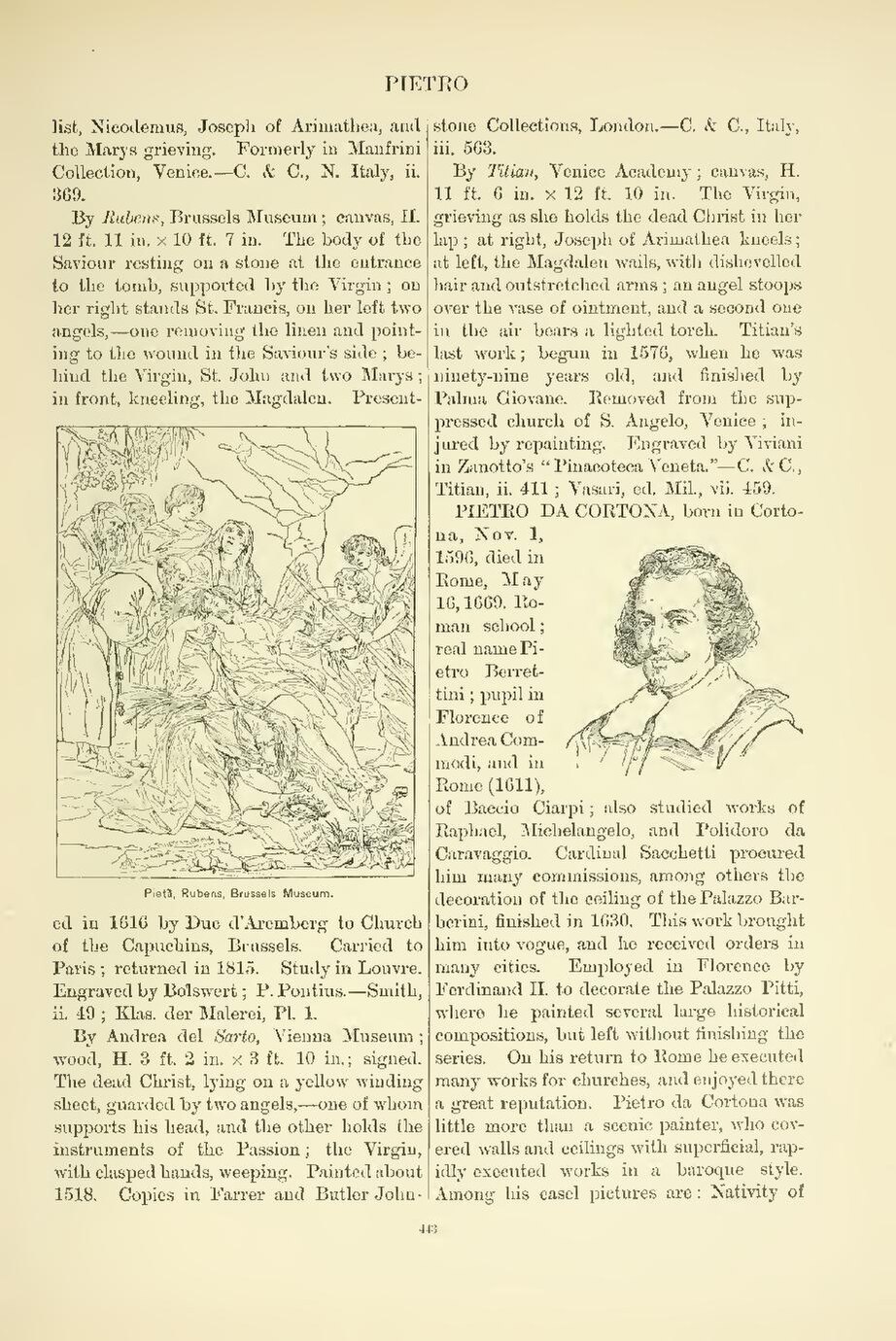- list, Nicodemus, Joseph of Arimathea, and
the Marys grieving. Formerly in Manfrini Collection, Venice.—C. & C., N. Italy, ii. 369.
An image should appear at this position in the text. To use the entire page scan as a placeholder, edit this page and replace "{{missing image}}" with "{{raw image|Cyclopedia of painters and paintings (IA cyclopediaofpain03cham).pdf/465}}". Otherwise, if you are able to provide the image then please do so. For guidance, see Wikisource:Image guidelines and Help:Adding images. |
Pietà, Rubens, Brussels Museum.
By Rubens, Brussels Museum; canvas, H. 12 ft. 11 in. × 10 ft. 7 in. The body of the Saviour resting on a stone at the entrance to the tomb, supported by the Virgin; on her right stands St. Francis, on her left two angels,—one removing the linen and pointing to the wound in the Saviour's side; behind the Virgin, St. John and two Marys; in front, kneeling, the Magdalen. Presented in 1616 by Duc d'Aremberg to Church of the Capuchins, Brussels. Carried to Paris; returned in 1815. Study in Louvre. Engraved by Bolswert; P. Pontius.—Smith, ii. 49; Klas. der Malerei, Pl. 1.
By Andrea del Sarto, Vienna Museum; wood, H. 3 ft. 2 in. × 3 ft. 10 in.; signed. The dead Christ, lying on a yellow winding sheet, guarded by two angels,—one of whom supports his head, and the other holds the instruments of the Passion; the Virgin, with clasped hands, weeping. Painted about 1518. Copies in Farrer and Butler Johnstone Collections, London.—C. & C., Italy, iii. 563.
By Titian, Venice Academy; canvas, H. 11 ft. 6 in. × 12 ft. 10 in. The Virgin, grieving as she holds the dead Christ in her lap; at right, Joseph of Arimathea kneels; at left, the Magdalen wails, with dishevelled hair and outstretched arms; an angel stoops over the vase of ointment, and a second one in the air bears a lighted torch. Titian's last work; begun in 1576, when he was ninety-nine years old, and finished by Palma Giovane. Removed from the suppressed church of S. Angelo, Venice; injured by repainting. Engraved by Viviani in Zanotto's "Pinacoteca Veneta."—C. & C., Titian, ii. 411; Vasari, ed. Mil., vii. 459.
An image should appear at this position in the text. To use the entire page scan as a placeholder, edit this page and replace "{{missing image}}" with "{{raw image|Cyclopedia of painters and paintings (IA cyclopediaofpain03cham).pdf/465}}". Otherwise, if you are able to provide the image then please do so. For guidance, see Wikisource:Image guidelines and Help:Adding images. |
PIETRO DA CORTONA, born in Cortona,
Nov. 1,
1596, died in
Rome, May
16, 1669. Roman
school;
real name Pietro
Berrettini;
pupil in
Florence of
Andrea Commodi,
and in
Rome (1611),
of Baccio Ciarpi; also studied works of
Raphael, Michelangelo, and Polidoro da
Caravaggio. Cardinal Sacchetti procured
him many commissions, among others the
decoration of the ceiling of the Palazzo Barberini,
finished in 1630. This work brought
him into vogue, and he received orders in
many cities. Employed in Florence by
Ferdinand II. to decorate the Palazzo Pitti,
where he painted several large historical
compositions, but left without finishing the
series. On his return to Rome he executed
many works for churches, and enjoyed there
a great reputation. Pietro da Cortona was
little more than a scenic painter, who covered
walls and ceilings with superficial, rapidly
executed works in a baroque style.
Among his easel pictures are: Nativity of
